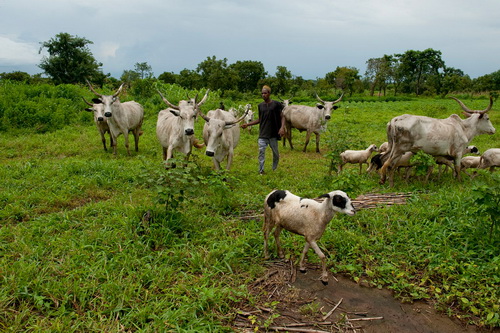
Herding livestock in Ta Kuti village, Nigeria. Photo: World Bank/Arne Hoel
30 May 2014 – The United Nations agricultural agency today announced that with Chinese partners, it has developed a new methodology which relies on soil sampling or computer modeling to measure the impact that restored grasslands have in mitigating climate change, and to help farmers tap into carbon markets.
Farmers rely on grasslands to feed the livestock, yet poor land management has left large swathes of the world’s grasslands degraded – an environmental problem which also has direct implications for livestock-dependent communities, the UN Food and Agricultural Organization (FAO) today said.
Measuring the impact of restoring grasslands – through more sustainable grazing practices and forage production – to link grasslands restoration with international climate financing schemes has been difficult. But this has been the focus of a partnership between the FAO and the Chinese Academy of Agriculture Science (CAAS), the World Agroforestry Center (ICRAF) and China’s Northwest Institute of Plateau Biology (NWIPB).
The UN agency announced that the tool created through this partnership has now been sufficiently tested, and endorsed by the non-profit Verified Carbon Standard (VCS), a voluntary greenhouse gas accounting programme used by projects around the world to verify and issue carbon credits in voluntary emissions markets.
According to findings from the case study in Northern China, improved practices could help herders sequester an average of 3 tCO2 (tons of carbon dioxide) per hectare of grassland each year over the next 20 years.
These practices include, for example, reduction and rotation of grazing pressure on overstocked sites and the sowing of improved pastures and fodder crops.
“Now that the tool has won the certification needed for recognition by international carbon markets, project developers and farmers have a new opportunity to implement grasslands restoration projects at a meaningful scale, improving the productive potential of their grasslands and helping to reverse historic carbon losses,” said Henning Steinfeld of FAO.
Returns from the carbon finance and other mitigation funds can be invested in further restoring the long-term health of the lands upon which herders and grazers depend and in building up marketing associations to improve their incomes, raising families incomes and improving household food security,” Mr. Steinfeld added.
CAAS and FAO are continuing to work together to identify opportunities to pilot this methodology and upscale its use in China and beyond, according to the UN agency. (UN News Center)
